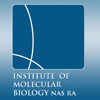|
General Information
History
The Institute of Molecular Biology (IMB) of the National Academy of Sciences of the Republic of Armenia (NAS RA) was founded in 1966 to encourage the development of molecular biology in Armenia. The research conducted in IMB in XX century had a significant input in the elucidation of structural and functional organization of nucleic acids, proteins, cells, and organelles.
Human Resources and Infrastructure
Total number of IMB employees is 130, among them 15 hold DrSc degree and 53 hold PhD degree. About 50% of IMB personnel are young scientists up to 35 of age. The IMB has 18 research units (1 department, 11 laboratories and 7 groups), and 3 educational units. IMB also has the Institutional Scientific Council, Young Scientists Council, and Ethics Committee. Among service units are: the Library, Human DNA Samples Bank, Cell Lines Collection, Animal House and the Institutional Local Area Network.
Main Fields of Activity
Current research activities of IMB are focusing on investigation of regulatory mechanisms of cell activity and its alterations in a number of pathologic conditions including autoimmune, autoinflammatory, cerebrovascular, infectious, oncological, and psychiatric disorders.
The research, conducting in vivo, in vitvo, in situ and in silico, includes human, animal, cell-cultures and computation modeling studies on genetic, protein, cellular, membrane, and sub-cellular levels.
A special attention is paid to mediators of the immune and signal transduction systems.
An important area of the research is Armenian genome study using pathogenomics, ecogenomics, immunogenomics, and population genomics approaches.
Main Results
Fundamental and Practical Significance of Research Results
The output of the studies performed at IMB is elucidation of molecular and cellular etiopathomechanisms of many polygenic and multifactorial diseases and identification of vital molecular biomarkers and therapeutic targets of diseases. Another important output is identification of new physiologically active compounds of potential therapeutic significance. Application areas include molecular diagnostics, prognostics, prophylaxis, and treatment of diseases, monitoring of disease progression and the efficiency of applied therapy as well as new drugs design. IMB has a number of technological developments in these fields and holds related patents.
Scientific Production and Technological Developments
Scientific production of IMB in the last years (2007-2013) includes 24 books/chapters, 216 papers in the international journals, 172 papers in the Armenian journals, 162 publications in the proceedings of the overseas scientific meetings, 196 publications in the proceedings of the scientific meetings organized in Armenia, and 12 patents. The IMB researchers developed novel test-systems for molecular diagnostics of schizophrenia and over-fatigue syndrome; innovative approach for individual selection of chemotherapy for treatment of different types of leukemia and solid tumors; new antiviral preparation for prevention and treatment of foot-and-mouth and Newcastle diseases, and some other products.
International Activity
IMB is integrated in the international research area establishing close partnership with internationally acknowledged research centers and universities worldwide.
Partnership is realized through exchange visits, implementation of joint projects, organization of joint conferences, seminars, workshops and trainings.
In the last years (2017-2013) the IMB researchers were actively participating in the international conferences and related events. Also, in the same years (2007-2013) 132 oral presentations and 86 poster presentations were made at the international conferences as well as 18 IMB scientists were awarded for the best presentations.
In addition, IMB is the organizer of many international conferences and related events in Armenia. In the last years (2007-2013) 6 international conferences, 1 workshop and 2 schools were held.
Other Information
Funding Sources and Research Grants
Basic activities of IMB have been funded from the state budget. In addition, IMB researchers have performed R&D projects supported by national and international grants provided on a competitive basis. Beginning from 2000 IMB researchers have implemented 89 projects supported by research grants.
Partner Organizations in Armenia
Among partner institutions in Armenia are the main universities, medical research centers, Institute for Informatics and Automation Problems of NAS RA and some other organizations. Partnership is based on S&T collaboration agreements and realized through implementation of joint projects, organization of joint educational units (department), laboratories, conferences, and workshops and trainings. IMB is a founder and facilitator of the Armenian Society of Biological Psychiatry, Armenian Association of Molecular and Cellular Biology and Immunology, a joint member of the Biotechnological Armenian Association, Electronic Library Consortium of Armenia, Technology Transfer Association as well as a partner of GARA (Global African Swine Fever Research Alliance).
|
